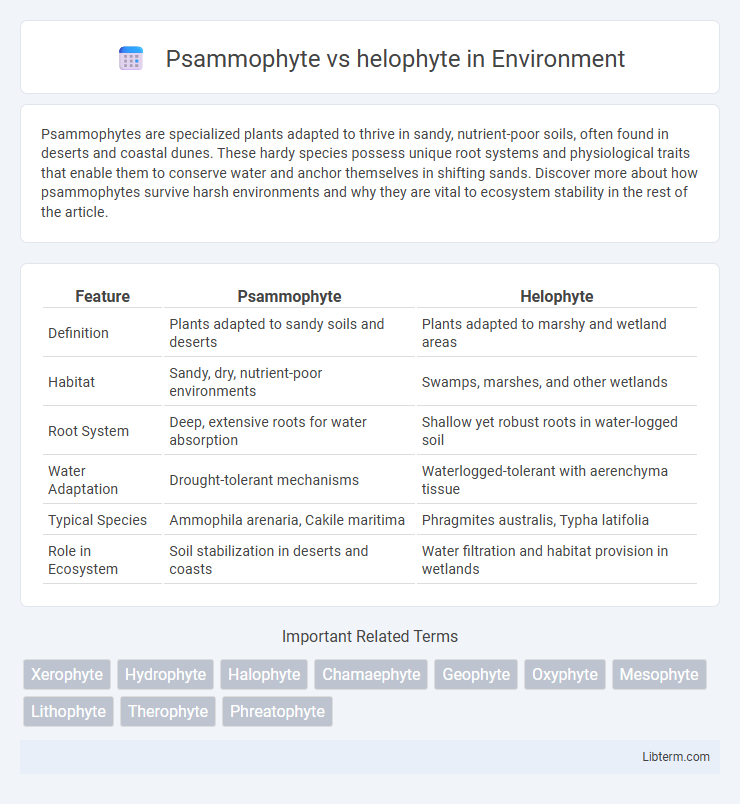Psammophytes are specialized plants adapted to thrive in sandy, nutrient-poor soils, often found in deserts and coastal dunes. These hardy species possess unique root systems and physiological traits that enable them to conserve water and anchor themselves in shifting sands. Discover more about how psammophytes survive harsh environments and why they are vital to ecosystem stability in the rest of the article.
Table of Comparison
| Feature | Psammophyte | Helophyte |
|---|---|---|
| Definition | Plants adapted to sandy soils and deserts | Plants adapted to marshy and wetland areas |
| Habitat | Sandy, dry, nutrient-poor environments | Swamps, marshes, and other wetlands |
| Root System | Deep, extensive roots for water absorption | Shallow yet robust roots in water-logged soil |
| Water Adaptation | Drought-tolerant mechanisms | Waterlogged-tolerant with aerenchyma tissue |
| Typical Species | Ammophila arenaria, Cakile maritima | Phragmites australis, Typha latifolia |
| Role in Ecosystem | Soil stabilization in deserts and coasts | Water filtration and habitat provision in wetlands |
Introduction to Psammophytes and Helophytes
Psammophytes are specialized plants adapted to thrive in sandy soils and coastal dunes, exhibiting drought tolerance and root systems designed for soil stabilization. Helophytes are aquatic or semi-aquatic plants found in marshes and wetlands, characterized by their ability to grow in waterlogged soils and facilitate nutrient cycling. Both groups play crucial ecological roles, with psammophytes preventing erosion in arid zones and helophytes supporting wetland biodiversity and water purification.
Definitions and Key Characteristics
Psammophytes are plants adapted to sandy, nutrient-poor soils, often exhibiting traits like deep root systems and tolerance to drought and shifting substrates. Helophytes, in contrast, are marsh or wetland plants that thrive in waterlogged, muddy environments, featuring aerenchyma tissues to facilitate gas exchange in saturated soils. Both plant types demonstrate specialized adaptations to extreme habitats but differ fundamentally in substrate preference and water availability.
Habitat and Environmental Adaptations
Psammophytes thrive in sandy, arid habitats such as coastal dunes and deserts, exhibiting adaptations like deep root systems to access scarce water and tolerance to nutrient-poor soils. Helophytes inhabit wetlands and marshes, developing specialized structures like aerenchyma tissue to facilitate oxygen transport in waterlogged, anoxic conditions. These contrasting environmental adaptations highlight psammophytes' resilience to drought and erosion versus helophytes' optimization for submerged, hypoxic ecosystems.
Morphological Differences
Psammophytes typically exhibit deep root systems and thick, waxy leaves to survive in sandy, nutrient-poor soils, while helophytes have extensive aerenchyma tissues and elongated stems suited for waterlogged, marshy environments. Psammophyte morphology is adapted to drought and instability with features like reduced leaf surface area, whereas helophytes possess specialized air channels to facilitate oxygen transport in submerged conditions. These distinct structural traits reflect their adaptations to contrasting habitats, influencing water retention, gas exchange, and mechanical support.
Root Systems and Water Relations
Psammophytes possess deep, extensive root systems that anchor them firmly in sandy, well-drained soils, allowing efficient access to scarce water resources and preventing desiccation. Helophytes feature shallow, fibrous roots adapted to waterlogged or marshy environments, facilitating oxygen uptake in anoxic substrates and efficient water absorption. These differences in root architecture and water relations reflect their specialized adaptations to contrasting ecological niches--arid, dry habitats for psammophytes and saturated, wet habitats for helophytes.
Ecological Roles and Significance
Psammophytes, specialized plants adapted to sandy soils, play a crucial role in stabilizing dunes and preventing soil erosion in arid and coastal ecosystems. Helophytes thrive in wetland habitats, contributing significantly to water filtration, nutrient cycling, and providing habitat for aquatic organisms. Both plant types enhance biodiversity and ecosystem resilience by supporting distinct ecological niches and promoting habitat complexity.
Geographic Distribution
Psammophytes predominantly inhabit sandy environments such as coastal dunes and desert margins, with significant populations found in arid regions across North Africa, the Middle East, and parts of Australia. Helophytes are primarily distributed in wetland areas, thriving in marshes, swamps, and riverbanks, commonly observed across temperate zones of Europe, North America, and Asia. Both plant types exhibit specialized adaptations that correlate with their distinct geographic and ecological niches.
Common Examples of Psammophytes and Helophytes
Common examples of psammophytes include grasses like Ammophila arenaria (marram grass) and shrubs such as Calligonum, which thrive in sandy, arid environments due to their drought-resistant adaptations. Helophytes are often represented by plants like Phragmites australis (common reed) and Typha latifolia (broadleaf cattail), commonly found in marshes and wetlands where their roots are submerged in waterlogged soil. These two plant types exhibit specialized adaptations for survival in distinctly different habitats, with psammophytes favored in sandy deserts and helophytes dominating aquatic or semi-aquatic ecosystems.
Human Uses and Applications
Psammophytes are plants adapted to sandy environments, commonly used in soil stabilization and desert reclamation projects to prevent erosion. Helophytes, thriving in marshy or aquatic habitats, play a crucial role in wastewater treatment through phytoremediation, filtering pollutants from water bodies. Both plant types contribute to sustainable environmental management by enhancing ecosystem resilience and supporting habitat restoration efforts.
Conservation Concerns and Future Perspectives
Psammophytes, specialized plants adapted to sandy and nutrient-poor soils, face conservation challenges due to habitat loss from coastal development and climate change-induced erosion. Helophytes, thriving in wetland ecosystems, encounter threats from water pollution, drainage, and land reclamation, leading to significant declines in biodiversity. Future conservation strategies must prioritize habitat restoration, protection of critical ecosystems, and research on species resilience to environmental changes to ensure the survival of both psammophyte and helophyte populations.
Psammophyte Infographic

 libterm.com
libterm.com